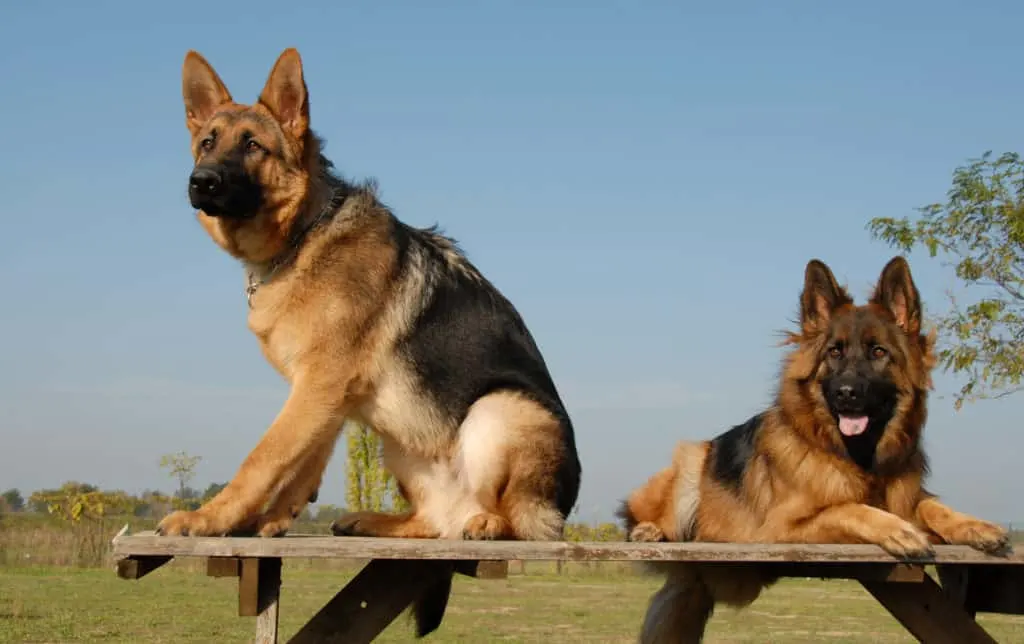
So you’ve made the decision to make a German Shepherd part of your family, yet you may still have one more really hard decision to make – should you get a male or female?
Consider your needs when buying a German Shepherd. Male German Shepherds tend to be more dominant and territorial than females, and they are also more protective of home and property. Females are more protective of individual family members and are generally easier to train.
You are also probably wondering what the differences are between them in terms of their behavior, their ability to get along with other people and animals, and so on. In this article, we’ll help you to understand these things so that you can make an informed decision for yourself.
Click Here to Jump to a Section
Male and Female German Shepherds at a Glance
Before we begin, here is a table to give you a better idea of male vs. female German Shepherds at a glance:
| German Shepherd | Male | Female |
|---|---|---|
| Larger in Size | ✅ | |
| Lives Longer | ✅ | |
| Health Problems | ✅ | ✅ |
| Better with Children | ✅ | |
| Easier to Train | ✅ | |
| More Territorial | ✅ | |
| More Dominant | ✅ | |
| More Possessive of Property | ✅ | |
| More Possessive of People | ✅ | |
| More Protective of Property | ✅ | |
| More Protective of People | ✅ | |
| Good with Other Dogs | ✅ | ✅ |
| More Aggressive | ✅ | |
| Better as a First Dog | ✅ |
Male vs. Female German Shepherd Physical Characteristics
Male German Shepherds weigh approximately 66 to 88 pounds. Larger than female GSDs, their height at the withers is typically around 25 inches.
(The withers is the ridge between a dog’s shoulder blades – this is the standard place from which to measure their height).
Female German Shepherds are typically between the weight of 49 to 71 pounds, and their height at the withers is on average 23 inches. They are typically leaner, lighter, and have less of a stocky build than male GSDs.
Both genders most often have medium-length coats, though there are four different coat lengths within the breed.

- Stock Coat: Short hair that lays flat against the dog’s body.
- Plush Coat: Though not an official term, “plush” is used to describe a GSD with a longer and fuller coat than a stock coat.
- Long Stock Coat: Just as it sounds, it is a long coat with both a fringe and an undercoat. The undercoat thins out in the summer and grows in more full in winter.
- Long Hair Coat: You won’t miss it if you see a GSD with a long hair coat. Long Hair Coat GSDs are in high demand because of their distinctive appearance.
Stock, Plush, and Long Stock Coat German Shepherds all have what is known as a double coat, which means that they have a top layer of hair that is dense, and a thick undercoat.
Long Hair Coat GSD’s have a single coat of hair. This is caused by a recessive gene, thus making these dogs somewhat of a rare find.
These different coats have significance for different Kennel Clubs throughout the world. For example, Long Hair Coat GSDs are accepted by German and UK Kennel Clubs, but under the American Kennel Club standards the Long Hair Coat is considered a fault and thus they do not allow them to be competed against the other three standard coat GSDs.
Is a Male or Female GSD Better with Children?
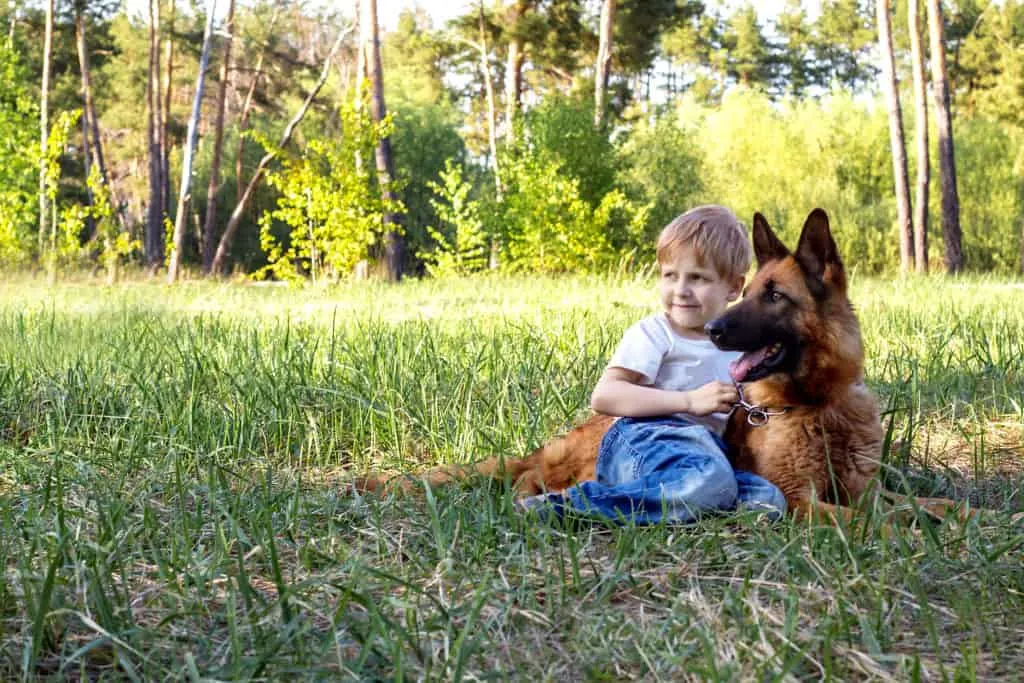
This is a very common question, and for good reason. You want to make sure if you have children, that they will not be in any danger if you decide to bring a German Shepherd into your home.
Generally speaking, you will be fine with either choice, it just depends on what type of behavior you prefer. While both genders are extremely self-confident and protective, they express these characteristics differently from one another.
A male GSD will tend to be more dominant, and may play around a little too rough for some people’s liking. They mean no harm, that’s just their nature. This by no means is to say that a male GSD is not good with children, it just means that you may have to pay more close attention to training your male GSD to be gentle around children than you would a female.
For a female GSD, her primary instinct is to bond with family, and especially children. It’s in her nature to be physically close and loving towards children, whereas males tend to be more straightforward and ready for play rather than cuddling.
For example, if there happens to be a child who is crying in the presence of a female GSD, she will likely address the situation by getting physically close to the child and licking the child’s face, while a male is more likely to bring the child a ball to play in order to solve the problem. True story!
Is a Male or Female GSD Better with Other Dogs?
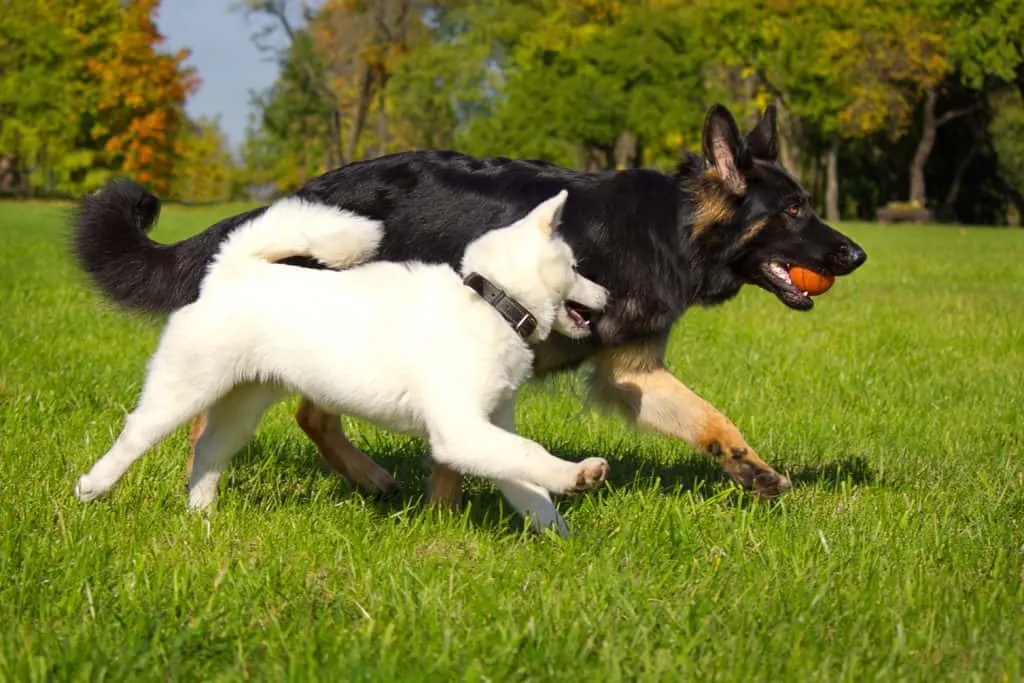
Regardless of whether a German Shepherd is male or female, they can and often do get along very well with other dogs, and other animals of all sorts for that matter. But how well they get along with other dogs is largely a product of how well the GSD has been socialized.
Socialization is the single most important aspect pertaining to how well a GSD will get along with other dogs. A GSD must be socialized from and early age. This process actually begins when the puppy is in the care of its mother and surrounded by its siblings, but after the dog leaves its original family it is entirely up to the dog’s new owner to properly socialize him.
Read a great article on how to socialize a Geman Shepherd here.
However, regardless of socialization, there may still be a time when a female GSD is not on her best behavior around another dog. This will often occur if there is another dog present in “her” household. As discussed above, female GSDs are very protective of their families.
So if there is another dog in the household, a female is more likely than a male to exhibit jealous behavior, because it’s “her” family. This may lead to some aggression on the part of the female GSD. How much jealousy the female displays will depend on her natural temperament and tolerance.
There is little that training can do to address this issue, so it’s important that before you bring a female GSD into your home, that you take into consideration whether you have another dog in the home as well.
Is a Male or Female GSD more Protective?
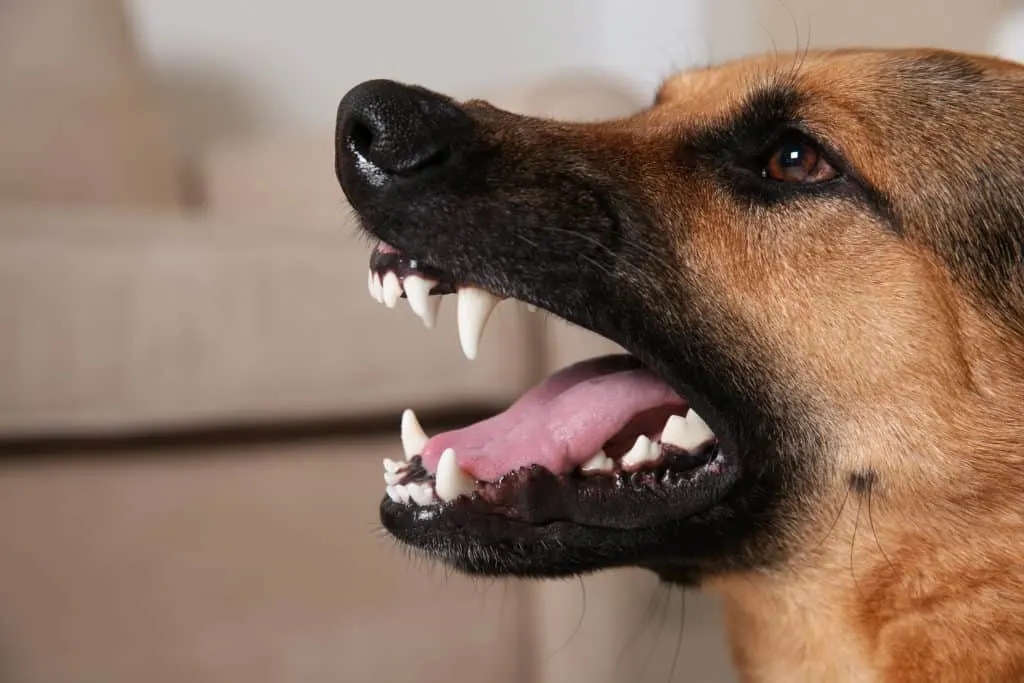
Male GSDs tend to be more territorial, which lends them to be more protective over your home and property lines. They will regularly patrol their territory and will keep a keen eye out for anyone who may be trying to enter your property or home.
Those of you who already have a male German Shepherd are no doubt familiar with the scenario where you are sitting down and perhaps watching tv, and then you hear it…that deep and low growl emanating from your GSD’s throat as it stares out of the window at someone approaching.
This behavior is common in male GSDs. They are very aware of their territory and its boundaries, and are always ready and eager to protect and defend it.
Male GSDs also tend to be more independent than females. When this is combined with their instinct to protect their territory, it sometimes leads to issues with them wandering off. Though this tendency will be less likely in a dog that is neutered.
It is, however, important to keep in mind that a German Shepherd should never be spayed or neutered too early in life. Neutering a GSD before it is at least one year old has been shown in a study to triple the risk of certain joint disorders.
A female GSD’s primary interest is not in protecting her property, but instead to offer protection to its inhabitants – you and your family. If a threat is sensed, a male GSD’s first instinct will be to secure the premises, and a female’s first instinct will be to make sure that the family is secure.
Both males and females will not hesitate to protect your family and your home with their lives, it’s just that the way they approach doing so is just a little different with each gender.
Does a Male or Female GSD Have More Health Problems?
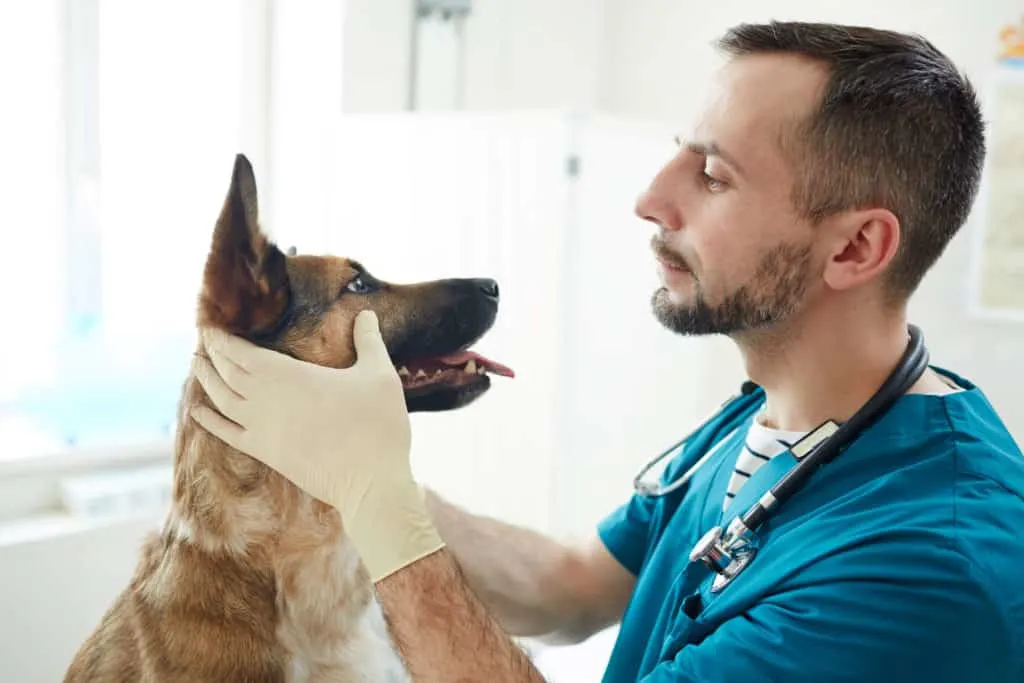
Both genders of GSD are prone to a particular set of health problems.
- Hip Dysplasia: Hip joints are not formed properly, causing cartilage to erode and the ball and socket joints to rub together.
- Exocrine Pancreatic Insufficiency: A digestive system disorder.
- Intervertebral Disc Disease: A spinal abnormality that is more common in some bloodlines than others.
- Osteochondrosis Dissecans (OCD): A genetic bone formation disorder.
- Panosteitis: Also known as “wandering lameness” or “long bone disease,” it typically affects GSDs under 14 months of age, though they usually grow out of it.
- Elbow Dysplasia: Here the bones of the GSD’s elbow joint to not grow properly.
- Degenerative Myelopathy: A progressive degeneration of the spinal cord which can lead to reduced function of a dog’s hind quarters, and in extreme cases even paralysis.
- Skin Problems: GSDs, because of their double coats, often experience extremely dry skin which causes them to release excessive pet dander.
- Hemophilia A: Although female GSDs carry this gene, it is most commonly found in males. This disorder prevents the dog from being able to adequately clot its blood.
- Pancreatitis: An inflammation of the pancreas, this is usually caused by a diet too high in fat.
- Diabetes Mellitus: This is similar to diabetes in humans, the culprit being the pancreas producing insufficient amounts of insulin.
- Progressive Retinal Atrophy (PRA): A hereditary condition that is relatively common in GSDs. It is a degeneration of the retina that usually begins at about two years of age and leads to poor eyesight.
- Sub-Aortic Stenosis (SAS): A congenital heart condition that if left untreated can be fatal.
- Epilepsy: There is no cure for this hereditary disease, though its effects on a dog can be treated and lessened with medication.
- Von Willebrand’s Disease (vWD): Similar to Hemophilia A described above, this disease also affects a dog’s ability to adequately clot its blood.
- Bilateral Cataracts: This condition presents itself with opaque spots on the eye, and can cause a loss of vision. If caught early enough, surgery may be an effective option to address it.
- Cherry Eye: This is an enlargement of the dog’s third eyelid tear gland, and appears as a bulbous red mass. Surgery to replace the gland may be recommended.
- Cryptorchidism: A genetic condition that only affects males, it causes one or both testicles to improperly descend into the scrotum.
- Bloat: This condition causes a dog’s stomach to produce excessive gas and become severely enlarged. It can be fatal if not treated immediately.
Whew, that’s a big list! But don’t let it get you too concerned – not all German Shepherds will have to endure these conditions/diseases. They are listed in the interest of being thorough because it’s important that you are aware of all possibilities of health issues with a GSD.
There are however a few conditions/tests that generally deserve more attention than the others.
The Canine Health Information Center (CHIC) collects health information on individual dogs and puts them in a database to help breeders make more informed choices about the dogs they breed.
A few of CHIC’s primary objectives are:
To collate and disseminate information concerning orthopedic and genetic diseases of animals.
To advise, encourage and establish control programs to lower the incidence of orthopedic and genetic diseases.
Canine Health Infomation Center Program Goals
The following are health screenings that are highly recommended for GSDs, and these are required for registration with the CHIC
- Hip Dysplasia
- Elbow Dysplasia
- Temperament Test
It’s a good idea to ask your breeder if they are CHIC certified before you move forward with getting a GSD from them. If they are not certified with CHIC, this is not necessarily a deal-breaker, but you should then be extra diligent about researching your breeder’s reputation and about getting personal references from them – and actually following up with the references!
Which One Lives Longer – a Male or Female GSD?
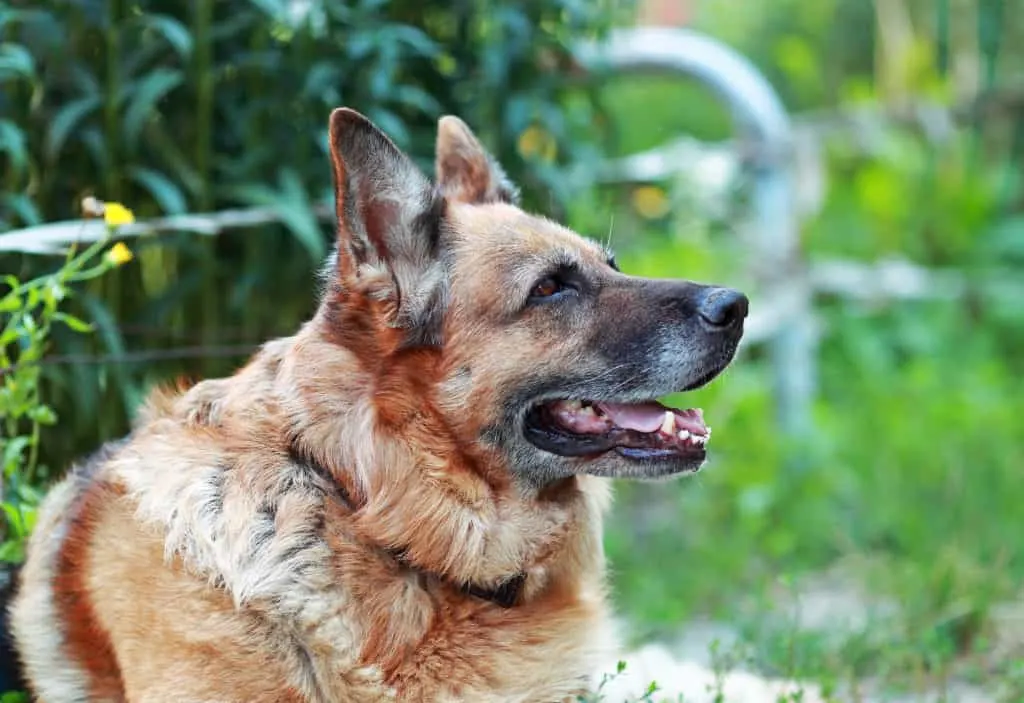
It’s commonly known that larger dogs tend to have a shorter life-span than smaller dogs. This disparity is most often attributed to genetic differences and pathological conditions that are a result of unnatural selection and a dog’s accelerated growth because of it.
As larger breed dogs, German Shepherds are already disadvantaged with having a shorter lifespan than smaller dogs. And within the GSD breed, males have a shorter lifespan than females. This has been concluded in a study on GSD mortality.
The study was comprised of 272 German Shepherds. It found that the median lifespan was 10.3 years for the dogs altogether. However, within this, it was found that females lived on average of 11.1 years, while males lived on average only 9.7 years.
These numbers indicate that on average a female German Shepherd will live 1.4 years longer than a male.
The study also concluded that whether the GSD was neutered made no statistical difference overall.
So, Which One Should You Get – a Male or a Female German Shepherd?
The answer to this is why you’re here in the first place, right?
The answer to this will depend on if this will be your first dog, or if it will be your first German Shepherd. Let’s now take a closer look at why these two distinctions are important to your decision.
First Dog?
If a GSD will be your first dog, then I would highly recommend that you make the choice of getting a female. Females, as discussed, are in general more gentle in their nature, but perhaps most importantly, they are typically easier to train than male German Shepherds.
If you have not had prior experience with training a dog, especially a German Shepherd, you may be biting off more than you can chew should you decide to opt for a male. Training a GSD is a lot of work. It requires patience, persistence, and repetition – a lot of it.
Even with a female GSD, you will still have your work cut out for you. Just because females are typically easier to train than males doesn’t mean that training them is an easy process by any stretch of the imagination. What it does mean is that with a female the training process may be more efficient, effective, and enjoyable for both you and your dog.
That said, it is not impossible for a first-time dog owner to properly train a male GSD. It most certainly can be done, but you should be very honest with yourself about your personal limitations and the time that you are actually willing to devote to training your dog.
As male GSDs are more dominant, they will often test their owners. If you push a male GSD mentally, it will push back. It’s all about how your dog views you.
Once a male GSD has established in his mind that he has dominance over you, then you will have a problem on your hands in the form of an unruly GSD that doesn’t think too much about listening to you over just behaving however he pleases.
Fortunately, the process for a first-time dog owner training a male, or even a female GSD can be helped along with the aid of a professional dog trainer. And it’s not a bad choice to at least begin the training them with a professional to make sure that your dog gets the fundamentals down properly instead of enlisting the help of a trainer after your dog has already developed a behavioral problem.
It is also very important when considering getting a German Shepherd that you understand all that you can about the breed, in general, and specifically.
You’ll find a few great resources here and here. What you’ll find in these articles is some good information to manage your expectations of your life with a GSD, and some very important questions that you should ask yourself before you decide to get one.
Not Your First Dog, but Your First GSD?
As long as you have prior experience training a dog of any type, then it’s a bit easier for me to suggest that you consider getting a male German Shepherd.
The biggest obstacles that must be overcome can all be handled with PPR (patience/persistence/repetition).
By having trained at least one other dog, you will have already gone through this process and have at least a basic knowledge of the effort required to properly train a dog. Though it is also very helpful to have experience with canine behavior in general, PPR is the core block from which successful training is built upon.
Final Thoughts
Once you’ve decided to welcome a German Shepherd into your life, understand this just the beginning of a process if you want to make sure that you get the right dog for you and your family.
This decision is your starting point, and from here you have a lot of work to do. Everything from talking with veterinarians, other GSD owners, breeders, shopping for puppy supplies, and getting educated on a proper diet for your dog are just some examples.
And as with everything from decision making to training, avoid the temptation to rush the process. Take your time and perform your due diligence – this will ensure that you and your new German Shepherd are a great match, and will enjoy years of happiness and fulfillment together.
